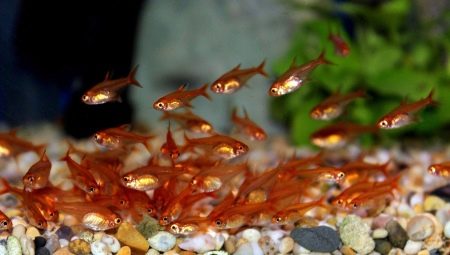Red nano-tetra is a freshwater fish, characterized by a bright color and small size. It has gained popularity thanks to its simple care and spectacular appearance, and you can also keep this underwater inhabitant in small aquariums.
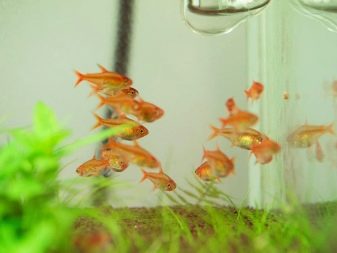
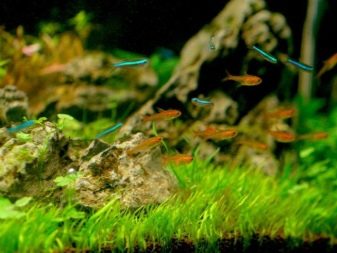
Description
The tiny fish has a flattened lateral body, painted in deep yellow, bright red or orange, with a length of not more than 2 cm. Its tail and fins are almost transparent, but on them you can distinguish light impregnations, folding in a kind of ornament.
The animal has large eyes with a black pupil of amber or orange color. Due to their size, the vision of the fish is particularly sharp. This advantage and a raised stigma allows the tetra to seek prey in the underwater plants. Females have a rounded abdomen, unlike males, which are also slightly smaller.
Dwarf amanda lives in flocks, and in the natural range - whole colonies. It is mobile and can move across the entire water column of the aquarium in small jerks, sometimes making absolutely synchronous movements with its relatives. The sleek and fragile nano-tetra features high adaptability, allowing it to quickly adapt to a wide variety of conditions.
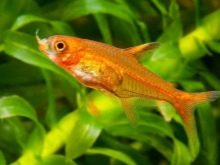
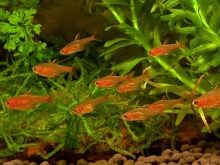

A feature of this decorative crumb is its ability to change color under stressful circumstances. So, getting into an artificial reservoir, the fish loses its bright color, becoming pale or faded pink. But as you get used to it, its natural beauty returns.
This inhabitant of tropical lakes and swamps is considered ideal for beginner aquarists, in good conditions the tetra can live 2-3 years. Of interest is the sociality of Amanda - it can be combined in schools with other small fish, in particular, with neon, the main thing is that their size does not exceed its own.

Conditions of detention
The red tetra cannot stand loneliness, therefore 10-15 fish should be purchased immediately. The approximate volume of water for two animals is 10 liters, so for ten fish, a capacity of only 50 liters with a tank wall height of at least 30 cm is quite suitable.
Such a southerner, like a dwarf tetra, prefers warm water with a temperature regime of 21-28 degrees. Other water parameters:
- rigidity - 1-12 units .;
- acidity - from 5 to 7 units.
Once a week, you will need to clean the soil and replace the water with 1/5 of the volume of water.
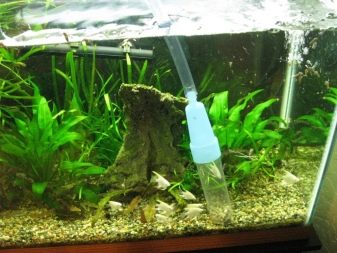
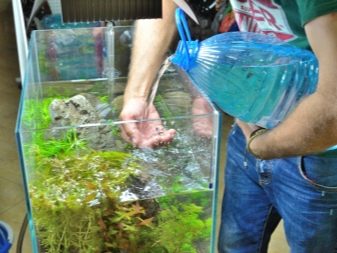
Additional recommendations for creating suitable conditions in the aquarium are presented below.
- Despite the fact that the fish are very active, and this requires a lot of free space, they need a lot of underwater vegetation. In natural conditions, they live in dim lighting and can’t tolerate bright light, so it’s so important to create shaded locations for them by placing different types of herbs, driftwood and rounded stones in the aquarium. A great addition will be artificial decorations. Soil and artificial structures must be cleaned every month.
- To recreate the natural landscape familiar to tetra, sandy, soft soil, preferably dark, is used. It is also advisable to place dry foliage of oak, alder, almond or birch on the bottom. This will not only decorate the artificial pond, but will also saturate the microenvironment with water-soluble polyphenol - tannin, which beneficially affects the immune system of fish. Periodically, such a substrate needs to be changed.
- To keep the water soft filtration can be applied with peat, which reduces its carbonate hardness. With small tank sizes, the aeration system can be neglected, but filtration is required in any case.
You should also make sure that the aquarium has a lid or you need to close the container with glass, as the tetra can jump out of the water.
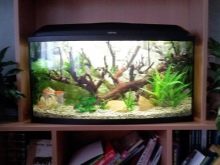
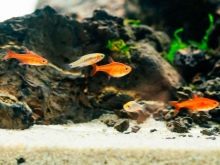
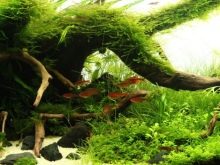
Diet and Feeding
In the wild, the food of amanda is small invertebrates and crustaceans, as well as other microorganisms, unicellular and colonial, which are zooplankton, unable to withstand water currents.
In a home aquarium, tetras willingly eat different types of food:
- ready-made feed in the form of flakes and granules;
- frozen food - red larvae of mosquitoes, bottom crustaceans (Artemia), daphnia, copepods, moin, which are preferred due to their meager size (1 mm).
Bloodworms and a finely chopped tubule are especially useful for fish, since they include hemoglobin, as well as carotene pigments, which add brightness to their color.
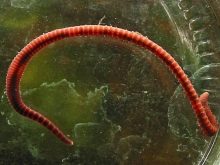
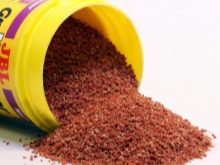
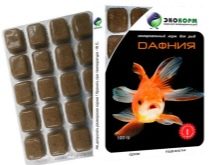
The nutrition of tetras provides for two or three times a day feeding in very small portions. It is good if the fish immediately eat the food, and it does not sink to the bottom.
The dwarf tetra has a small mouth, therefore any food must be thoroughly ground. In fish nutrition, diversity is important, on which both the activity of the underwater inhabitant and the presence of a spectacular color depend.
Amanda eats any food only afloat, that is, in the water column - this is due to the structure of her jaws, therefore the remaining food will fall to the bottom, from where the fish will not collect it.
If there is a large flock, experts recommend that small catfish of corridors be placed in the aquarium - they live in the bottom zone and will help clean the tank of food debris.
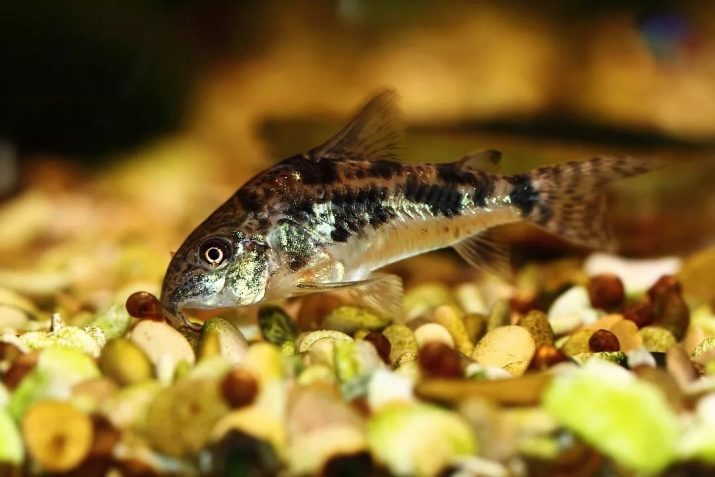
How to breed?
The reproduction of the tetra of Amanda can begin when the fish reach sexual maturity - 4 months. In fact, living separately from other types of tetra themselves will take great care of reproducing offspring. As a rule, females leave eggs on plants with small tender leaves.Later fry can feed on unicellular and other microorganisms trapped in an aquarium with dried tree leaves.
But often breeding is at risk due to the fact that adult fish can eat their tiny children. In this case, the breeding of fry in a separate container will help. You can do it correctly as follows:
- having selected the most beautiful and mobile fish, they need to be seated in different tanks;
- then begin to feed them in a variety of ways, giving increased portions;
- then prepare a separate container, creating ideal conditions for the couple - temperature 25-27 degrees, neutral acidity, diffuse lighting, you can put such an unassuming aquarium hydrobiont as Javanese moss on the bottom, and a fine-mesh separator mesh on top;
- in the evening during spawning, a couple of tetras are placed in this aquarium, and after the appearance of eggs, most often the very next day, they are returned to the reservoir for permanent residence.
From caviar, babies appear two days later and the first 2 days feed on their own reserves (yolk sac). After that, they can be fed with live dust, ciliates, washed with boiled yolk. As they grow, small crustaceans (cyclops) will become food for fry, nauplii will be the larvae of brine shrimp, and small primary cavernous worms will be rotifers.


What types are compatible?
Being predators in relation to small organisms, Amands are quite friendly towards other, equally small, peace-loving species.
Tetra can get along with such inhabitants of the underwater world as:
- melanotenia precox - neon iris;
- analysis from a family of cyprinids;
- school of zebrafish;
- ordinary neon (blue);
- Guppy aquarium live-bearing fish;
- the representative of the beaked feathery fish is a swordsman;
- a small armored catfish corridor, also living in packs.
Large and aggressive fish, including other types of ornamental catfish, should not be allowed to be accommodated with the amanda. But with predatory dwarf cichlids - apistograms, they coexist quietly, because they also live on the lower tier of an artificial reservoir.
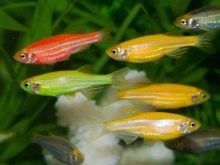
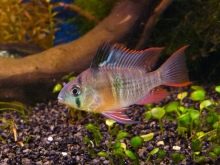

Those who breed Amanda Tetra for the first time need to know that a naturally healthy fish can become ill and die if it is improperly fed, sudden changes in temperature and changes in the composition of water, and a settlement with large fish leads to stress, which reduces its immunity. In this case, there is a chance of an infectious disease.
Experienced aquarists do not recommend keeping these fish in too warm water, although they feel comfortable in it. Better support temperature 20-23 degrees, since the cool environment extends tetra life up to 3-4 years, due to the slowdown of metabolic processes.
About the features of fish care tetra amanda, see the video below.
